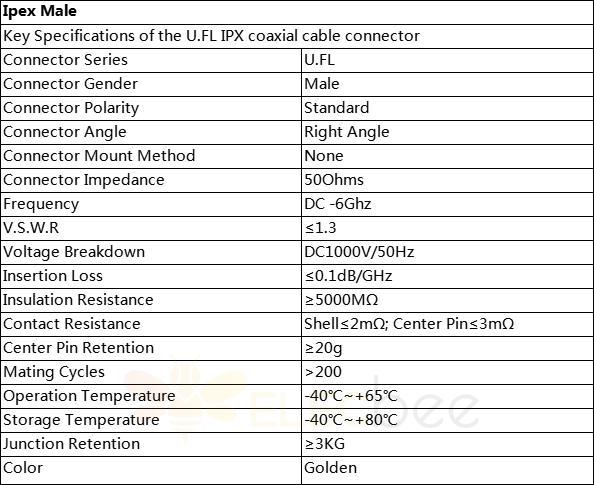I-PEX MHF Connectors are surface mount miniature RF connectors developed by I-PEX. These connectors were designed by I-PEX as an alternative to U.FL connectors (developed by the Hirose Electrical Group) and AMC Connectors (developed by Amphenol). These connectors offer high-frequency performance from DC to 6 GHz, but some connectors can operate up 9 GHz. They feature a nominal mated height of 2.5 mm max and have a small mounting area of 3 x 3.1 mm. These connectors are solderless and have a characteristic impedance of 50 ohms.
I-PEX MHF connectors are miniature surface-mount coaxial connectors, that are used in applications that have limited real estate. They can be used inside smartphones, laptops and embedded systems in order to connect the Wi-Fi antenna to a Mini PCI, Mini PCIe or M.2 WiFi card.
IPEX MHF is the first generation of IPEX micro RF coaxial connectors, and is compatible with U.FL connectors (Hirose) and AMC connectors (Amphenol). IPEX MHF are typically terminated with 1.13 mm and 1.32 mm coaxial cables. But now there are several RF connectors available like MHF37, MHF II/MHF2, MHF III/MHF 3, and MHF IV/MHF4, with various termination options - 1.37, 1.32, 1.13, 1.48, 0.81 mm, and RG178 cables. The IPEX MHF female connectors are surface-mounted and soldered directly on to the printed circuit board.
Key Features of I-PEX MHF Connectors
Surface mount miniature RF connectors
Operate from DC to 6 GHz (can operate up to 9 GHz)
Solderless micro-coax termination technology "i-Fit" and provide consistent performance.
These connectors are easy to remove by using proper extraction tools
Plugs are terminated with ultra-fine coaxial cables with a diameter of 1.37, 1.32, 1.13, 1.48, 0.81 mm. Also compatible with RG178 options
IPEX RF Connector Major Application
・Wireless LAN Antenna
・Cellular Phone
・Note Book Computer
・Game Equipment
・Digital Appliance
・Access Point
IPEX RF Connector Key Features
・SMT Receptacle and Mating Plug Cable Connector
・Small form factor and low profile: 1.2mm to 2.5mm MAX. Mating Height
– Applicable Cable:
O.D.0.64mm / 0.81mm / 0.98mm / 1.13mm / 1.32mm / 1.37mm and 1.8mm Coaxial Cable
– Applicable Technology:
IEEE802.11 a/b/g/n, UWB, WiMAX, iBurst, Zigbee, Bluetooth Wireless and MIMO・
Female U.FL connectors are not designed with reconnection in mind, and they are only rated for a few reconnects (approximately 30 mating cycles) before replacement is needed. The female U.FL connectors are generally not sold separately, but rather as part of a pigtail with a high-quality 1.32 mm doubly shielded cable, which allows for a low-loss connection.
The Specifications of U.FL Male

The male connectors are surface-mounted and soldered directly to the printed circuit board. They are designed to have a characteristic impedance of 50 ohms. The mated connection is only 2.5 mm high and takes as little as 9 mm2 of board space.

The cable-mount, right-angle plug is only available terminated either as a complete cable assembly or pigtail assembly. The connector assembly can be used in conjunction with our surface-mount PCB jacks, which are available in tape-and-reel packaging. Various RF connector interfaces are available as part of the micro-coaxial complete assembly.
The difference between the ceramic antenna and PCB antenna and IPEX antenna
A ceramic antenna is a miniaturized antenna suitable for Bluetooth devices. Ceramic antennas are divided into bulk ceramic antennas and multilayer ceramic antennas.
The block antenna uses high temperature to sinter the whole ceramic body at one time, and then print the metal part of the antenna on the surface of the ceramic block. The firing of multilayer antennas adopts low-temperature co-firing. The multilayer ceramics are laminated and aligned and then sintered at high temperatures.
Therefore, the metal conductor of the antenna can be printed on each ceramic dielectric layer according to the design needs, which can be effective. Reduce the size of the antenna and achieve the purpose of hiding the antenna. Since the dielectric constant of the ceramic itself is higher than that of the PCB circuit board, the use of ceramic antennas can effectively reduce the size of the antenna.
The PCB antenna refers to the part on the PCB for wireless reception and transmission.
When transmitting, it converts the high-frequency current of the transmitter into electromagnetic waves in space; when receiving, it converts the electromagnetic waves obtained from space into high-frequency current and input into the receiver.
Its advantages are less space occupancy, low cost, no need to assemble the antenna separately, not easy to touch and damage, easy assembly of the whole machine, but at a cost — sacrificing performance.
The disadvantages are a difficulty for a single antenna field to be rounded, high insertion loss, relatively low efficiency, and easy to be interfered with by the motherboard.
IPEX antenna is an interface between radio frequency circuit and antenna, which is widely used in wireless local area network (WLAN) related product single board.
Its advantages are field type can be controlled better, insertion loss is low, signal directionality is good, high efficiency, strong anti-interference ability, can reduce the interference on the motherboard, and does not require too much debugging and matching, as terminal manufacturing Or, you only need to connect an IPEX antenna outside;
Of course, there are drawbacks: the cost is high and it is more troublesome to assemble.
Elecbee is a company specializing in the development, production and sales of products such as electronic connectors, adapters and antennas. Whether it is technology, research and development, production, or business, they are in the leading position of the industry.
If you need any support from us, pls email us directly: service@elecbee.com, we are of service at any time.
